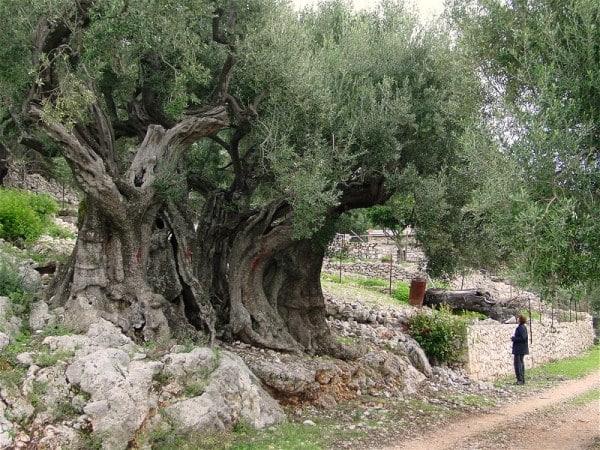
Athena and Poseidon compete under an olive tree
It all began with a contest. The Greek goddess of wisdom and warfare, Pallas Athena, and the Greek god of the sea, Poseidon, were vying for patronage of Greece’s most important city. Both promised its citizens a present. Poseidon wanted to offer as thanks a saltwater fountain, Athena an olive tree. The favourite daughter of Zeus was chosen, her present was the more convincing (after all, who wants a saltwater fountain?), and from then on the city was named Athens.

Olive trees in the Garden of Gethsemane

The Garden of Gethsemane, Andrea Mantegna c.1470
Some years ago I visited the Garden of Gethsemane (Hebrew: גת†שמנים†Gat-Schmanim, olive press) at the foot of the Mount of Olives in Jerusalem. It is believed to be the place where Jesus prayed after the Last Supper, before he was betrayed by Judas. The ancient, gnarled olive trees which are said to have stood in the garden then are still to be found there today. On seeing them you can well believe it, as apart from their enormous size, they seem to have more in common with abstract art than with plants. Being conscious of the significant occurrence which these olive trees are supposed to have witnessed, history and spirituality suddenly became very tangible for me in that instant.

Along with the olive tree the Kermes oak, the locust bean tree and the holm oak form the Mediterranean forest. The olive tree is probably also the most important representative of the Mediterranean cultural landscape. Scientists long believed that the plant was brought by man from Asia to Europe, yet fossil findings from Crete have since refuted this theory. In a volcanic eruption approximately 50,000 years ago, leaves from this tree were trapped in ash and so preserved to this day.

Our olive tree – planted – with lavender and sage

My fascination for this tree goes right back to my youth and childhood. I encountered it on numerous holidays to Italy, France and Spain, but only years later at the garden exhibition Giardina Zurich did I come across older specimens which so enthralled me that I resolved to obtain one of these “sculptures” for our own garden. Some time passed, and then one fine day in June, my business partner and I made a pilgrimage to a small village to the south of Lago Maggiore, to a business actually specialising in Christmas trees, but with a collection of 100- to 1500-year-old olive trees, one of which we chose. About three weeks later this almost five ton, approximately 400- year-old tree was delivered to us, and hoisted with a 60 ton hydraulic crane into our garden. In the days before its arrival we were occupied digging by hand a hole 3.5m long, 2.5m broad and 80cm deep. Now the crane driver just had to position the olive tree exactly in the hole, although until the very last moment we were unsure whether it would actually be big enough. We were enormously relieved to find we had measured accurately, the root balls had enough space! We were overjoyed. It is not just the tree’s marvellously structured wood which so enriches our lives, but more particularly its fruit and its oil. To make the raw fruits at all palatable, they must first be cured in water several times in order to wash away their bitterness. Who would have thought 20 to 30 years ago, that cold-pressed olive oil from Spain, France, Italy and Greece would experience such a boom in Central and Northern Europe? Today our cuisine is hardly imaginable without it, becoming as it does more Mediterranean by the year.

Travelling with my brother over a decade ago, I met an olive farmer in a southern French village in Languedoc, who turned out to have been France’s gold medal winner year on year in the 1990s. His olives, similar in size and shape to quail eggs, were served not in oil as is usual, but in brine. One evening we dined with him, and to accompany his olives and toast spread with fresh garlic and dunked in his own olive oil, he served us a wonderful amber coloured Muscat, which he had pressed and bottled with his father in the early 1950s. I have to admit, for me, this moment was quite simply the ultimate culinary experience, a complete back to basics. The German saying “Leben wie Gott in Frankreich” (living like God in France) certainly hits the mark.
Athena and Poseidon compete under an olive tree.
The Garden of Gethsemane, Andrea Mantegna c.1470.
Olive trees in the Garden of Gethsemane.
The painter Vincent van Gogh also very much concerned himself with these wonderful
plants during his years in St-Rémy-de-Provence.
Our own olive tree, still in its container.
Our olive tree – planted – with lavender and sage.
An older specimen.

Leave a Reply